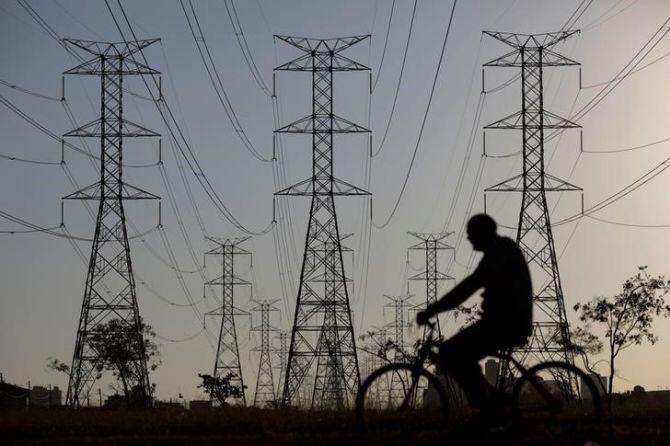 | « Back to article | Print this article |
Most of the economic activity in the country had come to a standstill after the government imposed a 21-day nationwide lockdown beginning March 25 to check the spread of coronavirus.

India's industrial production contracted by a record 16.7 per cent in March as restrictions imposed to curb the spread of coronavirus hit manufacturing and consumption.
The contraction in March came on the back of factory output rising to a seven-month high of 4.5 per cent in February before the government imposed a nationwide lockdown that crippled economic activity.
Manufacturing output contracted by 20.6 per cent in March from a year earlier, while electricity output shrank 6.8 per cent, according to official data released on Tuesday.
The mining output was flat in March.
The Index of Industrial Production (IIP) had grown by 2.7 per cent in March 2019.
Most of the economic activity in the country had come to a standstill after the government imposed a 21-day nationwide lockdown beginning March 25 to check the spread of coronavirus.
The lockdown has since been extended twice through May 17, with some relaxations to allow the resumption of economic activity.
The industrial output for 2019-20 ending March contracted 0.7 per cent over the previous fiscal.
The production output of eight core industries declined by 6.47 in March, down from 7.1 per cent in the previous month.
Separately, the government did not release headline retail inflation figures for April citing inadequate data collection under the lockdown.
The ministry of statistics said data are usually collected from 1,114 urban markets and 1,181 villages through personal visits, which have been suspended since March 19.
Commenting on the data, Suman Chowdhury, chief analytical officer, Acuite Ratings & Research, said March IIP print does not only reflect the impact of the disruptive COVID lockdown, which started in stages from mid-month but also the severity of the economic slowdown that had already gripped India.

"Even though all segments and categories have shown contraction, the 20.6 per cent drop in manufacturing output y-o-y is a highlight.
“The sectors like automobile (-49.6 per cent), electrical equipment (-31 per cent), computer hardware and optical equipment (-41.7 per cent) are clearly indicative of a broader slowdown aggravated by the lockdown.
“It, therefore, didn't come as a surprise that the capital goods segment contracted by a sharp 35.6 per cent and consumer durables by 33.1 per cent," he said.
The figures, he said, are expected to be "significantly worse" not only in the month of April but for H1FY21.
Nish Bhatt, founder & CEO of investment consulting firm Millwood Kane International, said a slump in IIP was on expected lines as there was near-zero productivity in factories.
"Going forward, the industrial activity will depend on how the government plans to lift the national lockdown and bring economic activity back on track," he said.
"The fall in IIP is likely to affect GDP data due later this month, a lot is hinging on government announcing stimulus measures to prop up the economy."
Finance Minister Nirmala Sitharaman has rolled out a Rs 1.7 lakh crore relief package comprising of free foodgrain to poor and cash to poor senior citizens and women, in an attempt to limit the economic damage caused by the pandemic and tackle loss of livelihood of millions of poor hit by the unprecedented lockdown.
On inflation data, Chowdhury said even though the data for April CPI is severely constrained, given the limited exercise for data collection, overall inflation of 5.5 per cent year-on-year was recorded in the month.
"Since core inflation has become insignificant at this time, food inflation is the primary concern recorded at 6.8 per cent," he said.
"Until lockdown is lifted and logistics bottlenecks are addressed, the risks of higher food inflation will remain, taking the overall CPI number well above the RBI threshold of 4 per cent."
Bhatt said there was a certain rise in food articles due to supply-side constraints.
According to the National Statistical Office (NSO) data, manufacturing sector output fell 20.6 per cent compared to a growth of 3.1 per cent in the same month a year ago.
Electricity generation declined by 6.8 per cent as against a growth of 2.2 per cent in March 2019.
Mining sector output remained flat compared to a growth of 0.8 per cent earlier.
The IIP in the last fiscal contracted by 0.7 per cent from 3.8 per cent expansion in 2018-19.
The data for March showed that production of capital goods, a barometer of investment, declined by 35.6 per cent as compared to a contraction of 9.1 per cent in the same month previous year.
As per use-based classification, primary good registered a contraction of 3.1 per cent, intermediate goods 18.5 per cent (-) and infrastructure/ construction goods 23.8 per cent (-) in March 2020 over the same period the previous year.
The consumer durables output fell 33.1 per cent, while non-durables production slipped 16.2 per cent in March.
In terms of industries, 7 out of 23 industry groups in the manufacturing sector have shown positive growth in March 2020.
Meanwhile, the retail inflation for March has been revised marginally lower to 5.84 per cent compared to 5.91 per cent estimated earlier, it added.
Photograph: Amit Dave/Reuters